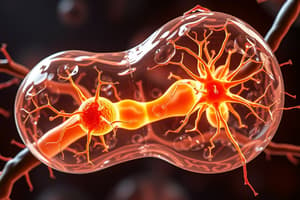Podcast
Questions and Answers
What is cellular respiration and what is its purpose?
What is cellular respiration and what is its purpose?
Cellular respiration is a catabolic reaction where nutrients are broken down to release energy in the form of ATP, and waste products are released.
What is the difference between aerobic and anaerobic respiration?
What is the difference between aerobic and anaerobic respiration?
Aerobic respiration requires oxygen, while anaerobic respiration does not.
What are the four stages of cellular respiration and what occurs during each stage?
What are the four stages of cellular respiration and what occurs during each stage?
The four stages of cellular respiration are glycolysis, formation of Acetyl CoA, Krebs cycle, and electron transport system. During glycolysis, glucose is partially oxidized to form pyruvate. In the formation of Acetyl CoA, pyruvate is oxidatively decarboxylated to form Acetyl CoA. During the Krebs cycle, Acetyl CoA combines with oxaloacetate to form citrate, which is fully oxidized and produces ATP and other high energy compounds. Finally, during the electron transport system, ATP is generated when electrons are transferred from energy-rich molecules to molecular O2.
Flashcards are hidden until you start studying




